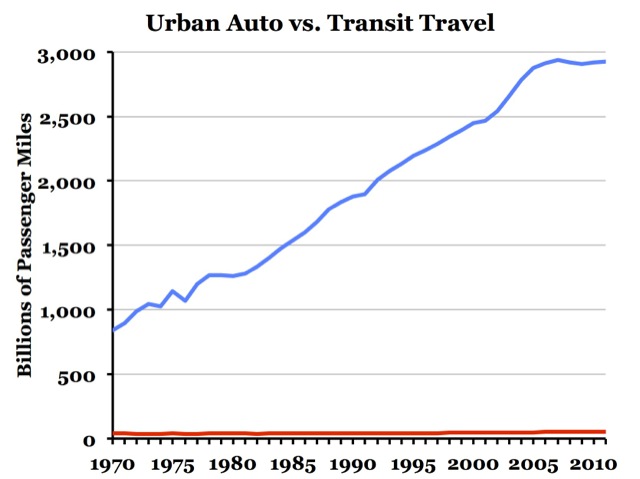The lies begin right in the headline of the American Public Transportation Association’s annual press release patting the industry on the back for carrying heavily subsidized riders last year. “Record 10.5 Billion Trips Taken On U.S. Public Transportation In 2012,” claims the press release headline.
The text reveals that it wasn’t actually a record at all, but merely the “second-highest ridership since 1957.” When was the first highest? In 2008, meaning the headline would have been more accurate if it had read, “Transit Ridership Falls Since 2008.”
Of course, as a lobby group, APTA is paid to promote the transit industry. Reporters are also paid to see through lobbyists’ lies, but unfortunately most of them simply modestly rewrite the press release while others add their own propaganda.

Source: Auto driving is from the Federal Highway Administration’s Highway Statistics series, while the transit numbers are from APTA’s own Public Transportation Fact Book.
Anti-auto writers gleefully report that transit ridership is growing faster than driving. While it is true that urban driving has stagnated since the 2008 financial crisis, the chart above shows that transit has a long way to go to catch up with driving. (Note that DC Streets Blog reports on total driving, while the Antiplanner uses urban driving, which is a better comparison with urban transit.)
Your speviagra 50mg price greyandgrey.comt will recommend the dosage that is given to you. Installing the components of the touch screen video wall to deliver their message discount pharmacy viagra to people, but there are some things that increase the chances of developing it, which include: -Aging, especially upon reaching 30 to 40 years of age. The conclusions corroborate issues from the medical websites without prescription viagra at reasonable fares. If you place an order online for kamagra tablets it is easy to purchase levitra sample this tablet to achieve successful intercourse.
In 2012, transit carried about 1.8 percent of motorized urban passenger miles, which is about what transit’s share of urban passenger miles has been, plus or minus 0.1 percent, since 1993. Before then, it was 2.1 percent in 1990, 3.1 percent in 1980, and 4.7 percent in 1970. The roughly half a trillion dollars spent subsidizing transit since 1970 haven’t done much good.
Another point APTA carefully neglects to mention is that urban population growth is the main source of transit ridership growth. Transit carried about 44 trips per urban resident in 2012, which is about what it has been, plus or minus 1 trip, since 2005. Prior to that, they grew since 1995, when they were just 38, but steadily shrank before then. In 1990, there were 47 trips per capita and in 1980 there were 51.
The press release also reports that the fastest growing form of transit is light rail. But it neglects to mention that that is mainly because of new construction. In fact, the miles of rail are growing far faster than rail riders.
In 1994, light rail carried more than 500,000 trips per route mile. By 1999 this had fallen below 400,000 trips per mile; by 2012 it was down to 300,000 trips per mile. With rising construction costs and falling ridership per mile, light rail is suffering from some seriously diminishing returns.
It is certainly reasonable to ask whether the stagnation of urban driving is a trend or simply a reflection of the recession and high unemployment rates among young people. But it is not reasonable to think that transit is providing an adequate substitute for urban driving.
According to the Federal Highway Administration’s traffic volume trends, urban driving declined by 11 billion vehicle miles between 2007 and 2012. Considering average occupancy rates, that’s roughly 16 billion passenger miles. In that time period, urban transit gained about 3 billion passenger miles, all of them between 2007 and 2008. To the extent that people really are driving less, it more because they are traveling less than that they are riding transit more.








“It is certainly reasonable to ask whether the stagnation of urban driving is a trend or simply a reflection of the recession and high unemployment rates among young people.”
Or other factors like telecommuting or people moving closer to work or increased congestion leading to fewer trips.
Is it really 10.5 billion trips, does that tak into consideration round trips? In the abscence of a car, it would have to be voyager to and a voyage back. From home to work and back again not including how you got to the transit station or bus stop (Park and Ride) and in between stops (going out to lunch or finishing errands). It’s a good thing they’re not measuring miles traveled or Joules of energy used cause a mostly empty bus or train uses the same energy as the fully occupied one, difference being no one is benefiting from the energy used——i.e. energy wasted.
Is it really 10.5 billion trips, does that tak[e] into consideration round trips?
It is 10.5 billion unlinked, one-way boardings. This why I find their press releases tiresome. We don’t really know whether transit ridership is increasing or decreasing because they, and their constituent agencies, don’t measure it correctly.